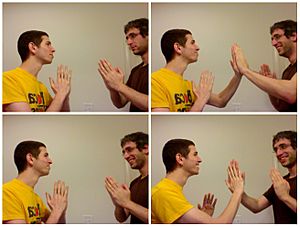Pat-a-cake, pat-a-cake, baker's man facts for kids
"Pat-a-cake, pat-a-cake, baker's man" is one of the oldest and most famous English nursery rhymes. It is also known as "Pat-a-cake" or "patty-cake". This rhyme is so well-known that it has a special number, 6486, in the Roud Folk Song Index, which keeps track of folk songs.
Contents
The Rhyme's Words
Here are the words to the classic "Pat-a-cake" rhyme:
- Pat-a-cake, pat-a-cake, baker's man.
- Bake me a cake as fast as you can
- Roll it, pat it, mark it with a "B"
- And put it in the oven for baby and me!
Where the Rhyme Came From
Early Appearances
The very first time this rhyme was written down was in a play. It appeared in a play called The Campaigners by Thomas D'Urfey in 1698. In the play, a nurse says a version of the rhyme to the children she is looking after.
Later, around 1765, another version of the rhyme showed up in a book called Mother Goose's Melody. This version was very similar to the one we know today:
- Patty Cake, Patty Cake,
- Baker's Man;
- That I will Master,
- As fast as I can;
- Pat it and prick it,
- And mark it with a T,
- And there will be enough for Tommy and me.
Why Mark the Cake?
You might wonder why the rhyme says to "mark it with a B" or "mark it with a T." This part of the rhyme comes from a time long ago. Many families did not have their own ovens at home. So, they would prepare their dough and take it to a local baker. The baker would then bake their items for a small fee.
Marking the pastry with a special letter or symbol was important. It helped people make sure they got their own baked goods back from the baker.
The Tune of Pat-a-Cake
The first time the "Pat-a-cake" rhyme was set to music was in 1796. A composer named James Hook included it in his work called 'A Christmas Box'.
The Pat-a-Cake Game
"Pat-a-cake" is often played as a clapping game between two people. Here is how it usually works:
- Players start by clapping their own hands together.
- Then, they clap both hands with the other person.
- Sometimes, players will cross their arms and clap the other person's hands in a criss-cross pattern.
This creates a fun and often fast sequence of claps. Both players need to work together to keep the rhythm. When parents play with a child, they often change the "B" and "baby" in the rhyme. They might use the child's first initial and first name instead. For example, "mark it with an 'A'" and "for Amy and me!"
Pat-a-Cake in Tennis
In Tennis, there is a special term called a pat-a-cake serve. This is a type of serve where the player does not swing the racket far behind their head. Instead, they make a shorter, simpler motion. This kind of serve is often used by players who are just starting out. It is also common for players who have not had formal training.



